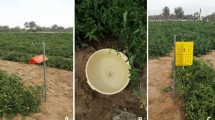Abstract
Melon fruit fly, Bactrocera (Zeugodacus) cucurbitae (Coquillet) (Diptera: Tephritidae) is a serious pest of cucurbitaceous vegetables in Bihar and cucumber is the most preferred host of the pest. The purpose of the current study was to identify the optimum height of trap to capture maximum number of fruit flies. The results showed that the maximum mean number of fruit flies (25.31 flies per trap per day) was caught in trap at a height of 35 cm and it was followed by 70 cm (19.29 flies per trap per day), whereas, the minimum (15.97 and 13.37 flies per trap per day) were caught at the height of 105 and 140 cm. Correlation study revealed that the height of the traps had highly significant and negative correlation (-0.980**) with number of fruit flies catches per trap at weekly interval, which indicates that the maximum fruit fly catches were obtained near the ground level where the fruit lies. Four species of fruit flies were trapped in the pheromone traps: B. cucurbitae, B. caudata, B. tau and B. nigrofemoralis. These present findings suggest that for the monitoring of fruit flies, the cuelure (p-acetoxyphenyl 2 butanic) traps should be hanged at the height of 35 cm from ground level to get the maximum counts of fruit flies.










Similar content being viewed by others
Availability of data and material
Data is completely transparent and all the data are completely taken by us from field.
Code availability
Not applicable.
References
Ahwiyah ES, Fatahuddin A, Andi N (2017) Effect of sticky trap color and height on the capture of adult oriental fruit fly, Bactrocera dorsalis (Hendel) (Diptera: Tephritidae) on chilli pepper. Am J Agric Biol Sci 12(1):13–17
Akhtaruzzaman M, Alam MZ, Ali-Sardar MM (2000) Suppressing fruit fly infestation by bagging cucumber at different days after anthesis. Bangladesh J Entomol 9:103–112
Atakan E, Canhilal R (2004) Evaluation of yellow sticky traps at various heights for monitoring cotton insect pests. J Agric Urban Entomol 21:15–23
Dhillon MK, Singh R, Sharma Naresh JS, HC, (2005) Evaluation of bitter gourd (Momordica charantia L.) genotypes for resistance to melon fruit fly Bactrocera cucurbitae. Indian J Plant Prot 33(1):55–59
Dhillon MK, Singh R, Sharma NJS, HC, (2005b) The melon fruit fly, B. cucurbitae: A review of its biology and management. J Insect Sci 5:40–60
Dhillon MK, Singh R, Naresh JS, Sharma HC (2005) The melon fruit fly, B. cucurbitae: review of its biology and management. J Insect Sci 5:40–60 (http://www.insectscience.org)
Drummond F, Groden E, Prokopy RJ (1984) Comparative efficacy and optimal positioning of traps for monitoring apple maggot flies (Diptera: Tephritidae). Environ Entomol 13:232–235
GCYD, Mandal CK (2000) Integrated management of fruit fly (Bactrocera cucurbitae) on bitter gourd (Momordicha charantia L.) during the summer of (1998/99). IAAS Res. Rep. 1995–2000:171–175
Gupta D, Verma AK (1992) Population fluctuations of the maggots of fruit flies Dacus cucurbitae Coquillett and D. tau (Walker) infesting cucurbitaceous crops. Adv Pl Sci 5:518–523
Jacob J, Leela NK, Sreekumar KM, Anesh RY, Heema M (2007) Phytotoxicity of leaf extracts of multipurpose tree against insect pests in bitter gourd (Momordica charantia) and brinjal (Solanum melongena). Allelopathy J 20(2):1–2
Jiji T, Simna T, Abraham V (2009) Effect of heights of food bait trap on attraction of melon flies (Diptera: Tephritidae) in cucumber. Pest Manag Hort Ecosyst 15(1):48–50
Jiji T, Stonehouse JM, Mumford JD, Abraham V (2005) Heights of food bait trap attraction of melon fruit flies (Diptera: Tephritidae) in bitter gourds in southern India. Int J Trop Insect Sci 25(4):292–294
Kapoor VC (2004) Fruit fly pests and their present status in India. Proceedings of 6th International Symposium on Fruit Flies of Economic Importance, pp 23–33. 6th -10th May, 2002. Stellenbosch, South Africa
Liburd OE, Polavarapu S, Alm SR, Casagrande RA (2000) Effect of trap size, placement and age on captures of blueberry maggot flies (Diptera: Tephritidae). J Econ Entomol 93:1452–1458
Neupane FP (2000) Integrated management of vegetable insects. CEAPRED, Bakhundol, Lalitpur, Nepal. 172 p
Palaniappan SP, Annadurai K (2006) Organic farming: Theory and practices. Scientific Publishers, Jodhpur, p 257p
Reissig WH (1975) Performance of apple maggot traps in various apple tree canopy positions. J Econ Entomol 68:534–538
Satpathy S, Rai S (2002) Luring ability of indigenous food baits for fruit fly B. cucurbitae (Coq.). Indian J Ent Res 26(3):249–252
Shooker P, Khayrattee F, Permalloo S (2006) Use of maize as a trap crops for the control of melon fly, B. cucurbitae (Diptera: Tephritidae) with GF-120. Bio-control and other control methods [Online]. http//www.fcla. edu/FlaEnt/fe87 p354.pdf. [Retrieved on: 20th Jan. 2008]
Teixeira LAF, Polavarapu S (2001) Effect of sex, reproductive maturity stage and trap placement, on attraction of the blueberry maggot fly (Diptera: Tephritidae) to sphere and Pherocon AM traps. Florida Entomol 84:363–369
Vicente NL, Sandra V (2014) Mass Trapping for Fruit Fly Control. In: Shelly T, Nancy E, Eric BJ, Jesus RF, Roger V (eds) Trapping and the Detection, Control, and Regulation of in Tephritid Fruit Flies. Springer, Dordrecht, pp 513–558
Acknowledgements
This study was funded and supported by Dr. R.P. Sharma, Associate Dean-cum-Principal, Bihar Agricultural University, Sabour, Bhagalpur, Bihar, India.
Funding
Bihar Agricultural University, Sabour, Bhagalpur, Bihar, India.
Author information
Authors and Affiliations
Contributions
Complete execution of the experiment, designed of the experiment, collection of the data, and identification of the species.
Corresponding author
Ethics declarations
Conflicts of interest/Competing interests
Not applicable.
Additional information
Publisher's Note
Springer Nature remains neutral with regard to jurisdictional claims in published maps and institutional affiliations.
Rights and permissions
Springer Nature or its licensor (e.g. a society or other partner) holds exclusive rights to this article under a publishing agreement with the author(s) or other rightsholder(s); author self-archiving of the accepted manuscript version of this article is solely governed by the terms of such publishing agreement and applicable law.
About this article
Cite this article
Saha, T., Chandran, N. Evaluation of optimum heights of pheromone trap on attraction of fruit flies (Diptera: Tephritidae) in cucumber in North Eastern India. Int J Trop Insect Sci 43, 289–295 (2023). https://doi.org/10.1007/s42690-023-00942-7
Received:
Accepted:
Published:
Issue Date:
DOI: https://doi.org/10.1007/s42690-023-00942-7




